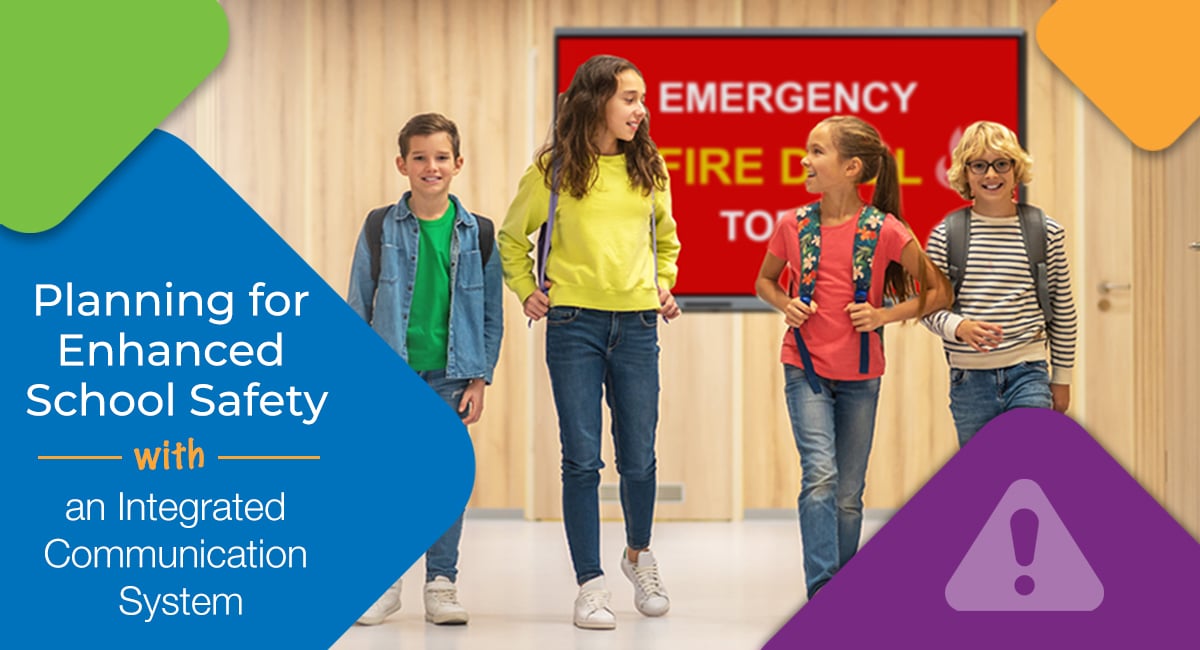
School safety is a critical concern for many school districts, as administrators aim to make teachers, students, and parents feel secure in their schools. At one time, schools were considered one of the safest places for our children. Changing times have required that districts take a serious look at how they ensure safety, so children can learn and explore comfortably.
Threats to school security and safety require an integrated approach that includes a well-designed plan for emergency situations, training materials and staff designated and responsible for executing emergency plans, and a comprehensive communication platform that includes alarms, bells, intercom, silent alerts, visual communications, and alert buttons.
When designing your system, key guidelines should be considered. In part one of this two-part series on building a campus emergency system, we will focus on what goes into the design and planning of the system. We will also delve into what states are doing to improve safety standards in schools. In part two, procedures will be discussed.
Planning the Communication System
Planning a unified communication system for emergency notification and response purposes should include a risk assessment to determine appropriate equipment, operational procedures, and personnel required to meet all stakeholders' objectives. The risk analysis process involves a systematic multi-step process, including the formation of a team, analysis of buildings and spaces to be protected, assessing potential threats, identifying specific countermeasures, and developing an emergency response plan. The risk analysis should consider hazards from natural disasters, accidental hazards, and malicious threats and/or activities. Countermeasures should mitigate the potential for incidents and minimize the effects of one if it occurs. Communication with emergency responders like local police and fire department, as well as with parents should also be considered in the planning process. Documentation of the risk assessment, emergency response plan, and resulting actions should be reviewed, updated, and socialized regularly.
Communication System Design
The communication system design is ideally based on the school's emergency response plan, which should include procedures for responding to several types of emergencies, such as fires, severe weather, and intruders. The system design should be flexible and scalable, allowing for expansion or modification or for adaptability in the event of an unexpected type of emergency event. Redundancy and interoperability are also key. This will ensure that communication can be maintained or restored quickly if a system failure arises.
Sound Intelligibility
Sound-reinforcement design principles are important in ensuring the effectiveness of emergency communications. Intelligibility can be affected by several factors, such as background noise, speaker placement, and direct vs. indirect sound. It is important to consider the interface with fire alarm systems and mass notification systems, emergency takeover procedures, and communication accessibility to those with hearing or visual impairments. Reliability and operational integrity are also crucial considerations in the design and maintenance of school communication systems.
What States Are Doing
Because of the heightened focus on school safety, states are allocating money toward improving safety measures on campuses. For example, Texas has proposed a School Safety Standards Rule to “address school safety and ensure minimum school safety standards to address the safety of students and staff alike” in their public schools. This proposed rule requires school systems have the appropriate components to help improve the safety and security of school facilities, staff, students, and visitors. This includes a silent, panic alert system that can be triggered by staff and simultaneously alerts school administrators, law enforcement, and staff.
Florida, New Jersey, and New York have enacted laws that require panic alert devices in all classrooms and Oregon is forwarding similar legislation, as well as a bill that would require schools to send electronic notifications to parents as soon as a safety threat occurs.
For districts that do not have state legislation and/or funding to augment safety measures already in place, safety-specific grants are available to help with the investment and implementation of such measures. SchoolSafety.gov’s Grant Finder Tool helps schools and districts find applicable funding opportunities. To help schools and districts navigate grant applications, Boxlight has a free Grant Assistance Program (GAP) that can help coordinators with the process and find additional funding opportunities. To learn more about GAP, click here.
Updating school safety procedures and systems requires serious and often uncomfortable conversations, ongoing and long-term resources and investment, and vigilance. Well-prepared plans and robust systems help make everyone feel more comfortable, and learning remains the focus at school. School districts that are “ready for anything” not only ensure safety but the social and emotional well-being of everyone on campus.
To learn how Boxlight solutions, like the award-winning Attention!, can support your school safety plan click here.


